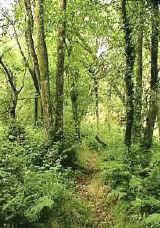Types of Woodland
|
 |
Woodlands can be divided into two main types, coniferous and broadleaf. Within these two general categories are many other different types. These are usually classified according to the dominant tree species making up the woodland.
|
Coniferous woodland, as its name suggests, is made up predominantly of conifers. Conifers are trees often having needle-like leaves, such as the familiar Christmas tree. They are usually evergreen. In other words, rather than shedding their needles all at one time in the autumn, they lose a proportion throughout the year, with these being constantly replaced. As a result, they always have foliage on them. There are exceptions to this. For example, European Larch is deciduous, dropping all of its needles in the autumn. All conifers also produce their seeds inside cones. |
||
| . | . | ||
|
Broadleaf woodland is composed of trees with leaves which are not needle-like. The leaves of different broadleaf trees come in all varieties of shapes and sizes, but tend to be flat, broad shapes quite unlike the needles of conifers. Most broadleaf trees in Britain are deciduous. This means that they lose all their leaves in the autumn, remaining bare through the cold winter months until the spring, when they grow new foliage. Some broadleaf trees however, are evergreen, rather than deciduous. Holly is an example. The seeds of broadleaf trees are produced within a great variety of different structures, from acorns to berries. |
||
| . Coniferous and broadleaf trees are adapted to different climatic conditions. Conifers are the dominant tree form in very cold climates, where snow and freezing conditions are the norm in winter. The conical shape of the whole tree encourages snow to fall off the branches rather than settling. This reduces the risk of large accumulations of snow, which are very heavy and might cause branches to break under the weight. Coniferous trees also have resins in their sap which vary with the species of conifer. These act as a kind of antifreeze, preventing internal damage to cells by the formation of sharp ice crystals. . .
.
|
|||



